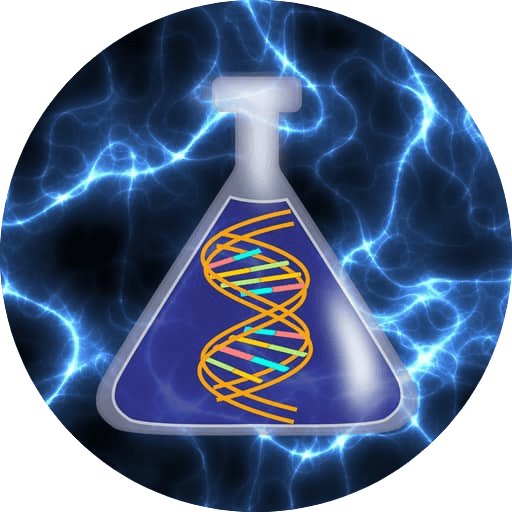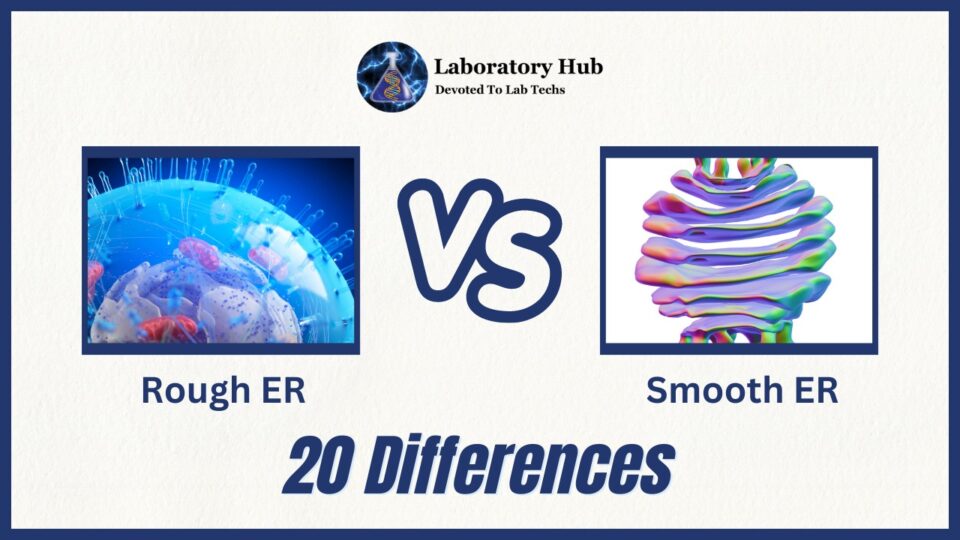The endoplasmic reticulum (ER) is a vital organelle found in eukaryotic cells that plays a crucial role in various cellular processes. It consists of two main types: rough endoplasmic reticulum (RER) and smooth endoplasmic reticulum (SER). While they are interconnected and have some overlapping functions, they also possess distinct characteristics and perform different roles within the cell.
The rough endoplasmic reticulum (RER) is so named due to its rough appearance, which is attributed to the presence of ribosomes attached to its outer surface. These ribosomes are responsible for protein synthesis, making the RER a site of active protein production. The RER is particularly abundant in cells that produce and secrete large amounts of proteins, such as plasma cells and pancreatic cells. It is involved in the synthesis, folding, and modification of proteins, as well as their transportation to other cellular compartments or for secretion outside the cell.
In contrast, the smooth endoplasmic reticulum (SER) lacks ribosomes on its surface, giving it a smooth appearance under the microscope. The SER is involved in various metabolic functions and lipid synthesis. It plays a significant role in the detoxification and metabolism of drugs, toxins, and other harmful substances. Additionally, the SER is responsible for the synthesis of lipids, including phospholipids and steroids, as well as the storage and regulation of calcium ions.
Also Check: 48 differences between UTIs and yeast infections
Both the RER and SER are interconnected and share a common membrane network. They communicate and exchange materials through small vesicles that transport molecules between the two compartments. This connectivity allows for coordination and efficient transfer of proteins and lipids within the endoplasmic reticulum system.
While the RER and SER have distinct functions, it’s important to note that these functions are not entirely exclusive, and there can be some overlap. For example, both organelles are involved in the production of membrane components and contribute to the overall integrity and structure of the cell. Additionally, they can communicate and cooperate in certain cellular processes, such as lipid metabolism and calcium regulation.
In summary, the rough endoplasmic reticulum (RER) and smooth endoplasmic reticulum (SER) are two interconnected but functionally distinct organelles within the eukaryotic cell. The RER is involved in protein synthesis, modification, and trafficking, while the SER participates in metabolic processes, lipid synthesis, and detoxification. Understanding the characteristics and functions of these two subcellular compartments is crucial for comprehending the complex machinery of cellular processes and the maintenance of cellular homeostasis.
Also Check: 28 Crucial Differences between Iron Deficiency and Anemia
|
S.No. |
Category |
Rough ER |
Smooth ER |
|
1 |
Presence of Ribosomes |
Rough ER is studded with ribosomes on its surface. |
Smooth ER lacks ribosomes on its surface. |
|
2 |
Appearance |
Rough ER has a rough or granular appearance due to the presence of ribosomes. |
Smooth ER has a smooth or tubular appearance without ribosomes. |
|
3 |
Location |
Rough ER is located adjacent to the nucleus and extends throughout the cytoplasm. |
Smooth ER is found in close association with the rough ER or scattered throughout the cytoplasm. |
|
4 |
Protein Synthesis |
Rough ER is involved in the synthesis of proteins, especially those destined for secretion or insertion into membranes. |
Smooth ER is not directly involved in protein synthesis. |
|
5 |
Protein Folding |
Rough ER provides a site for proper folding and modification of newly synthesized proteins. |
Smooth ER does not play a direct role in protein folding. |
|
6 |
Protein Transport |
Rough ER serves as a transportation network for proteins to be transported to other organelles or the cell surface. |
Smooth ER is not directly involved in protein transport. |
|
7 |
Lipid Synthesis |
Rough ER is involved in the synthesis of membrane phospholipids. |
Smooth ER is the primary site for lipid synthesis, including the synthesis of phospholipids, cholesterol, and steroid hormones. |
|
8 |
Detoxification |
Rough ER does not have a major role in detoxification processes. |
Smooth ER is involved in detoxification processes, such as drug metabolism and detoxification of harmful substances. |
|
9 |
Calcium Storage |
Rough ER has a limited role in calcium storage. |
Smooth ER plays a major role in calcium storage, regulating calcium ion concentrations in the cytoplasm. |
|
10 |
Glycosylation |
Rough ER is involved in the addition of sugar moieties to proteins, a process called glycosylation. |
Smooth ER does not play a direct role in glycosylation. |
|
11 |
Membrane Integrity |
Rough ER contributes to the maintenance and integrity of the cellular membrane system. |
Smooth ER also contributes to the maintenance and integrity of the cellular membrane system. |
|
12 |
Secretory Vesicle Formation |
Rough ER is involved in the formation of secretory vesicles for protein export. |
Smooth ER is not directly involved in secretory vesicle formation. |
|
13 |
Protein Quality Control |
Rough ER is involved in protein quality control, identifying and eliminating misfolded or damaged proteins. |
Smooth ER does not have a direct role in protein quality control. |
|
14 |
Golgi Apparatus Interaction |
Rough ER is closely associated with the Golgi apparatus, facilitating the transport of proteins between these organelles. |
Smooth ER has limited interaction with the Golgi apparatus. |
|
15 |
Membrane Lipids |
Rough ER synthesizes phospholipids for incorporation into cellular membranes. |
Smooth ER synthesizes phospholipids and helps maintain lipid homeostasis. |
|
16 |
Lipid Metabolism |
Rough ER has a minimal role in lipid metabolism. |
Smooth ER is involved in lipid metabolism, including fatty acid metabolism and synthesis of lipids like triglycerides. |
|
17 |
Steroid Hormone Synthesis |
Rough ER is not directly involved in steroid hormone synthesis. |
Smooth ER is the primary site for the synthesis of steroid hormones, including estrogen and testosterone. |
|
18 |
Muscle Cells |
Rough ER is abundant in muscle cells, especially in the sarcoplasmic reticulum, which is involved in calcium storage and release. |
Smooth ER is also present in muscle cells but is less abundant compared to the rough ER. |
|
19 |
Phospholipid Exchange |
Rough ER facilitates the exchange of phospholipids with other cellular membranes. |
Smooth ER does not have a direct role in phospholipid exchange. |
|
20 |
Phospholipid Bilayer Formation |
Rough ER contributes to the formation of the phospholipid bilayer in cellular membranes. |
Smooth ER also contributes to the formation of the phospholipid bilayer in cellular membranes. |
Also read: Innate Immunity vs Adaptive Immunity- 35 Differences
Frequently Asked Questions (FAQs)
Q1. What gives the rough endoplasmic reticulum its rough appearance?
The rough endoplasmic reticulum (RER) appears rough due to the presence of ribosomes attached to its outer surface.
Q2. What is the main function of the rough endoplasmic reticulum?
The RER is primarily involved in protein synthesis, modification, and trafficking within the cell.
Q3. How does the smooth endoplasmic reticulum differ from the rough endoplasmic reticulum?
The smooth endoplasmic reticulum (SER) lacks ribosomes on its surface and is involved in various metabolic functions, lipid synthesis, and detoxification.
Q4. Can the rough endoplasmic reticulum perform functions other than protein synthesis?
Yes, the RER also plays a role in the folding, modification, and transportation of proteins within the cell.
Q5. What types of cells have a particularly abundant rough endoplasmic reticulum?
Cells that produce and secrete large amounts of proteins, such as plasma cells and pancreatic cells, have an abundant RER.
Q6. What are some functions of the smooth endoplasmic reticulum?
The SER is involved in lipid synthesis, including phospholipids and steroids, as well as the detoxification and metabolism of drugs and toxins.
Q7. How do the rough and smooth endoplasmic reticulum communicate with each other?
The RER and SER are interconnected and communicate through small vesicles that transport molecules between the two compartments.
Q8. Can the rough and smooth endoplasmic reticulum perform overlapping functions?
Yes, there can be some overlap in functions, such as their involvement in membrane component production and their contribution to cellular structure.
Q9. Is the smooth endoplasmic reticulum involved in calcium regulation?
Yes, the SER participates in the storage and regulation of calcium ions within the cell.
Q10. Are there any diseases or conditions associated with dysfunction of the endoplasmic reticulum?
Yes, endoplasmic reticulum stress and dysfunction can contribute to various diseases, including neurodegenerative disorders and metabolic diseases.
User Review
( votes)
Laboratory Hub aims to provide the Medical Laboratory Protocols & General Medical Information in the most easy to understand language so that the Laboratory Technologist can learn and perform various laboratory tests with ease. If you want any protocol to be published on Laboratory Hub, Please drop a mail at contact@laboratoryhub.com. Happy Learning!

